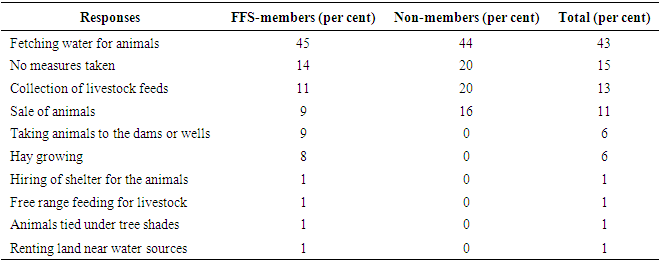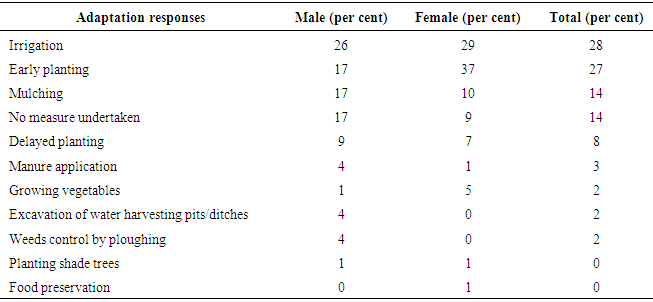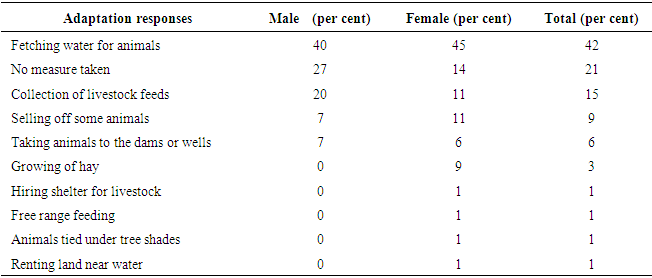-
Paper Information
- Paper Submission
-
Journal Information
- About This Journal
- Editorial Board
- Current Issue
- Archive
- Author Guidelines
- Contact Us
International Journal of Agriculture and Forestry
p-ISSN: 2165-882X e-ISSN: 2165-8846
2017; 7(3): 67-75
doi:10.5923/j.ijaf.20170703.02

The Contribution of Farmer Field Schools in Facilitating Smallholder Farmer’s Adaptation to Drought in Kiboga District, Uganda
David Mfitumukiza 1, Bernard Barasa 1, Lynne Carter 1, Anna Maria Nankya 2, Grace Nansamba 3, John Francis Okiror 4, Ivan Lukanda 4, May Sengendo 3, Michael Ssekaayi Mbogga 2
1Makerere University Centre for Climate Change Research & Innovations, Kampala, Uganda
2Department of Forestry, Biodiversity and Tourism, Makerere University, Kampala, Uganda
3School of Women and Gender Studies, Makerere University, Kampala, Uganda
4Department of Journalism and Communication, Makerere University, Kampala, Uganda
Correspondence to: Bernard Barasa , Makerere University Centre for Climate Change Research & Innovations, Kampala, Uganda.
| Email: |  |
Copyright © 2017 Scientific & Academic Publishing. All Rights Reserved.
This work is licensed under the Creative Commons Attribution International License (CC BY).
http://creativecommons.org/licenses/by/4.0/

Farmer Field Schools (FFS) represent a significant step forward in agricultural education by facilitating farmers adapt to drought. The purpose of this study was to examine the contribution of FFS in facilitating smallholder farmer’s adaptation to drought in Kiboga District inclusive of gender and communication perspectives. A total of 120 FFS-members and 60 non-members were randomly selected and administered with questionnaires in Kapeka, Dwaniro and Bukomero sub-counties. Using descriptive statistics, the results revealed that in crop production, the FFS members largely responded to drought by early/delayed planting, carrying out micro-irrigation, growing of vegetables, rainwater harvesting and application of organic manure; while in livestock production, they fetched water, sold livestock, grew hay, hired shelter for livestock protection and collected feeds. These divergent options were incomparable to those applied by the non-FFS members. Irrespective of memberships, the women were more directly involved in crop and livestock adaptation related activities compared to their counterparts. In addition, both FFS members and non-members revealed to have implemented adaptation responses learnt from fellow farmers, friends, community announcers, extension officers and local council leaders. As a result, the application of adaptation responses increased the smallholder farmer’s social relations, income levels and food security status.
Keywords: FFS-members, Non-FFS-members, Crop and Livestock Production, Gender, Communication, Kiboga
Cite this paper: David Mfitumukiza , Bernard Barasa , Lynne Carter , Anna Maria Nankya , Grace Nansamba , John Francis Okiror , Ivan Lukanda , May Sengendo , Michael Ssekaayi Mbogga , The Contribution of Farmer Field Schools in Facilitating Smallholder Farmer’s Adaptation to Drought in Kiboga District, Uganda, International Journal of Agriculture and Forestry, Vol. 7 No. 3, 2017, pp. 67-75. doi: 10.5923/j.ijaf.20170703.02.
Article Outline
1. Introduction
- Smallholder farmers in the developing countries are among the most vulnerable categories of people to the impacts of drought partly due to their dependence on natural resources, low social capital, poor access to climate information as well as poor technology and rural roads (Adger et al., 2003; Morton, 2007; Wood et al., 2010; Conway & Schipper, 2011). Drought causes the drying up of surface and ground water sources and destruction of tree cover that acts as the shelter for animals (Hughes et al., 2000; Watson & Albritton, 2001; Parker et al., 2007; Parry, 2007; Solomon et al., 2007). These have deprived the farmers of benefiting from livestock and crop production through reductions in milk yield and beef products and poor harvests that attract low market prices (Hulme et al. 2005; Okonya & Kroschel, 2013; Dube & Phiri, 2013).In adaptation to this situation, Famer Field Schools approach has been used as a platform to help farmers improve their food security status. A Farmer Field Schools (FFS) approach offers a significant step towards improved sharing of farming information vital to increasing their resilience (Feder et al. 2004; Davis et al., 2012) through the promotion of science-based knowledge and practices (Doss, 2001; Gershon et al., 2004; Godtland et al. 2004; Bunyatta, et al., 2006; Siregar & Crane, 2011). The approach uses demonstrations to transfer knowledge and skills in sustainable crop cultivation, livestock production and sustainable natural resource management (Okoth et al., 2002; Simpson & Owens, 2002; Anandajayasekeram et al., 2007; Duveskog, 2011). The learned and adapted measures enhance the livelihood of smallholder farmers through facilitating them with innovative technologies and market information (Thiele et al., 2001; Godtland et al., 2004; Mancini et al., 2007; Braun & Duveskog, 2011). In addition, according to Egeru (2012), he revealed that most Ugandan farmers learned adaptation responses from radios simply because of high penetration and affordability. Despite the FFS membership and non-membership, farmers continue to face challenges in adaptation to drought such as low crop yields and limited water and pasture that affect their crop and livestock productivity (Taylor et al., 2012; Waddington et al. 2014). Although drought affects everyone, it is not gender neutral. For instance, women in the developing countries are more vulnerable to the impacts of drought than the men as primarily their livelihood is dependent on the natural resource base (Mehra & Gammage, 1999; Davis, 2008, Orlove et al., 2010). This is worsened for women because they have lower legal and social status as well as fewer household property ownership rights compared to men. The women also have limited decision-making power and are rarely given opportunities to exercise their voice, due to the established social norms identified above (Anderson & Feder, 2004; Hemmati & Rohr, 2007; Jost et al., 2015). There are more women than men active in the agricultural sector, and women have been shown to be more likely to undertake drought adaptation responses such as irrigation, hay growing and harvesting rainwater (Kabeer, 2005; Boserup et al., 2007; Morrison et al., 2007; Ogunlela & Mukhtar, 2009).This study took into consideration a wide spectrum of available literature and observed that few studies have specifically documented the contribution of FFS in facilitating smallholder farmer’s adaptation to drought including gender roles and information accessibility. This study bridged this information gap by establishing the contribution of FFS in facilitating smallholder farmer’s adapt to drought in Kiboga District inclusive of gender and communication perspectives. The specific objectives of this study were to (i) assess the contribution of FFS in helping their members adapt to drought and (ii) examine the challenges faced by both the FFS-members and non-members in adaptation to drought.
2. Methods
2.1. Description of Study Area
- The study was carried out in Kapeka, Dwaniro and Bukomero sub-counties that lie in the western part of Kiboga District located in mid-central Uganda (Figure 1). The location is 385242.8 (Longitude) and 294728.3 (Latitude) - WGS 1984 UTM Zone 36N. The sampled area borders the districts of Kyankwanzi to the North, Mubende to the West and Mityana to the South. The studied sub-counties are situated in the cattle corridor characterised by low and unreliable rainfall received throughout the year that affects both crop and livestock production in the region (Ssewanyana & Ahmadi-Esfahani, 2001). The area experiences a bimodal type of rainfall with an annual average of 1,197mm. Drought is usually experienced in the months of June - July and December - February of each year, though the patterns of occurrence have changed over time. The topography is categorised into two distinctive zones namely: undulating topography and plateau. The zones are characterised by grasslands, swamps, bushland and thickets, swamp forests, papyrus, reeds and sedges. In terms of water resources, the sub-counties have numerous rivers such as Kafu, Mayanja, and Mpongo that drain into Lake Kyoga. The main soil type that underlies Kapeka and Dwaniro is ferrasol which has a fine granular structure. The hydrogeomorphic soil, on the other hand, cover Bukomero sub-county and is made up of river alluvium dominated by sandy clays.
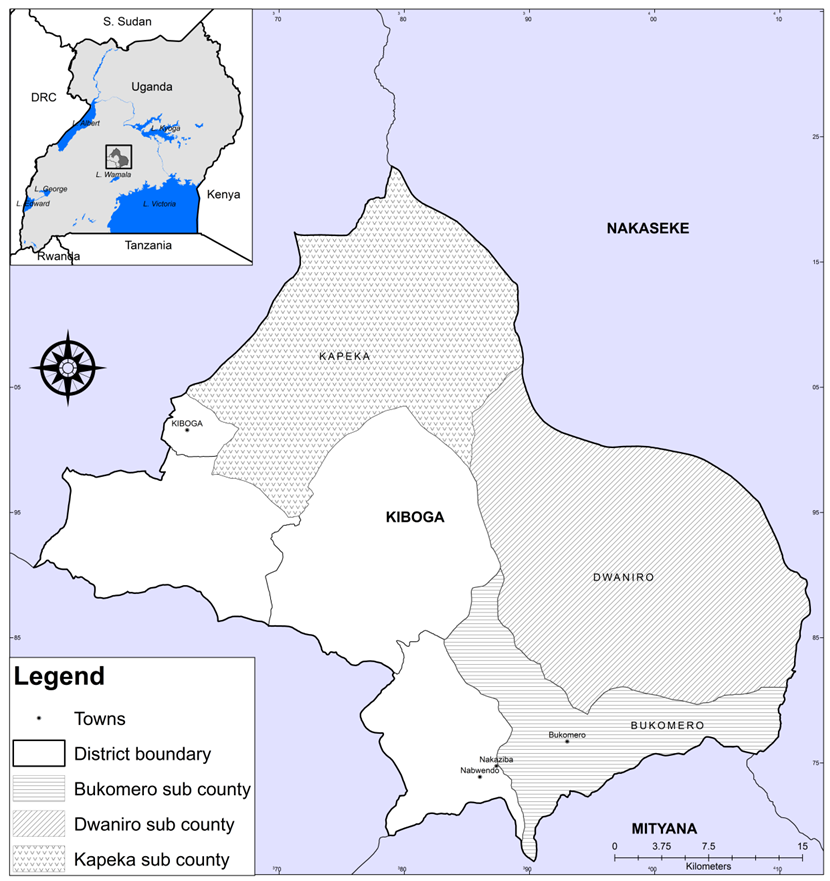 | Figure 1. Sampled sub counties (Kapeka, Dwaniro and Bukomero) in Kiboga District |
2.2. Establishment of Farmer Field Schools in Kiboga District
- The Hunger Projects Uganda (THPU) in partnership with the communities formed Farmer Field Schools (FFS) as symbols of partnership, mobilisation of communities and discovery learning. Since inception in Uganda in 1999, THPU has established eleven FFS epicentres in the districts of Mpigi, Butambala, Wakiso, Kiboga, Kyakwanzi, Mbarara, Kiruhura, Iganga and Mbale. The Hunger Project-Uganda received funding from FAO to increase community resilience to climate change effects through Farmer Field Schools (FFS) in Kiboga district in the sub- counties of Kapeka, Dwaniro and Bukomero. This work was implemented under the framework of the Global Climate Change Alliance (GCCA), which supported Uganda Adaptation to Climate Change in Agriculture project. The FFS were made up of farmers both male and female that came together with common needs, challenges or problems. In their gatherings, the farmers were taught by FFS facilitators through discovery method of how to solve their agricultural challenges. Each FFS group consisted of 10-25 members. There was no specific admission criterion, although farmers had to be residents of that particular sub-county where the school was established. Any farmer who wished to join was allowed to register with the FFS facilitator at the beginning of the growing season. The Farmer Field Schools approach was undertaken to partly allow for easy assessment and quantifying of the impacts of FFS towards assisting the farmer’s adaptation to drought effects in the study area (Davis & Nkonya, 2008).
2.3. Study Design and Data Collection Tools Used
- The study used questionnaires, focus group discussion (FGD) and key informant guides as explorative socio-economic data collection instruments to achieve the objectives of the study. The instruments were designed to provide both qualitative and quantitative drought adaptation responses undertaken by both the FFS members and non-members that could be treated statistically. The instruments were designed based on a comprehensive understanding of cropping calendar and livestock rearing methods and intensity, and literature review for attitude measurement in the study area.The study area had 52 FFS fully registered with a membership of 1,014 (401 males, 613 females) participants. In particular, Dwaniro sub-county had 32 FFS conducted in 4 parishes while Kapeka sub-county had 20 FFS carried out in 3 parishes. Thirty out of 52 FFS were selected to study the drought adaptability measures undertaken in both crop and livestock production with the guidance of the facilitators. Four FFS members from each group were randomly selected using the membership list from each production category for interviewing. A total of 120 FFS members were selected and interviewed using a household questionnaire. The members were interviewed during the rainy season partly because this was the busiest time in FFS learning calendar where validations, multiplication and commercial enterprises were mainly grown at the study sites and individual households. The non-FFS members were also randomly selected using the village membership list by the study. The local leaders selected the members basing on the degree of crop and livestock production engagements. A total of 60 non-FFS members were also randomly selected (20 in Dwaniro, Bukomero and Kapeka sub counties respectively) and interviewed from their homesteads. The subjects interviewed included crop and livestock production drought adaptability measures.The study also conducted key informant interviews. The key informants were purposively selected because of their knowledge and expertise in crop and livestock production for interviewing. The key informants interviewed included FFS facilitators, Food and Agriculture staff, local government agricultural, production, community development and environmental officials following Kumar (1989) procedures for conducting key informant interviews in developing countries. The discussions helped to validate some of the findings presented by both the FFS members and non-members during the interviews. In addition, both the FFS members and non-FFS member’s adaptation responses were also validated during the focus group discussions (FGDs). Two focus group discussions were conducted in both Dwaniro and Kapeka sub-counties. The FGDs had between 10-12 members who were selected and mobilised by their group leaders. The topics discussed included frequency and severity of drought, adaptation responses in crop and livestock production, challenges and recommendations among others. The discussions provided a rich description of complex contributions of FFS in helping farmers understand and respond to the impacts of drought (Sofaer, 1999). The collected socio-economic data were examined and entered into SPSS software version 16.0 for descriptive statistical analysis.
3. Results
3.1. Sources of Livelihood for the FFS-Members and Non-Members
- Economically, the majority of the FFS-members and non-members majorly engaged in crop growing and livestock production as their main source of income; while the rest operated small scale trade businesses, formally employed, performed wage labour and were also indulged in food processing activities. The FFS members equally engaged in both crop and livestock production compared to the non-members (Table 1).
|
3.2. The Contribution of FFS in Facilitating Their Members to Adapt to Drought
3.2.1. Crop Production
- The application of drought adaptation responses by farmers can be determined by the level of knowledge, experience and skills attained in farm management. This was observed by the FFS-members who responded to the severity of drought by practicing; bottle irrigation, delayed planting, mulching, growing of vegetables and early planting, planting of shade trees, food preservation and water harvesting (Table 2). Bottle irrigation referred to the collection and filling of plastic water bottles with water. The bottles were then inserted into the ground, upside down near the crown area to irrigate the individual plants through dripping. The application of drought adaptation responses by non-FFS-members showed that 31 per cent out of 60 respondents did not apply any measure while, fewer applied mulching, irrigation, early planting, application of manure or controlled weeds by ploughing.
|
|
3.2.2. Livestock Production
- The FFS helped their members to adapt to drought by also training them in livestock adaptation measures that included fetching water for the animals (45 per cent out of 120 respondents). Analysis of livestock related adaptation data showed that those who harvested and stored feeds for livestock totalled 11 per cent. Nine per cent were engaged in the selling of livestock, growing of hay and taking animals to the dams /wells respectively, while one per cent got involved by hiring shelter for animals to provide shade from heat waves, practiced free range feeding of livestock, tied animals under tree shades and rented land near water sources (Table 4). On the other hand, the non-members responded to drought (44 per cent out of 60 households) by also fetching water for the livestock though they applied limited water use efficiency techniques, 20 per cent adapted by harvesting feeds for livestock, while 16 per cent took part in the sale of animals to avoid loss to death. Sale of animals is typically a last resort action when farmers have run out of options to save the livestock from drought. The study, therefore, shows that there was the minimal application of adaptive response by the non-members, compared to FFS members.
|
|
3.3. The Challenges Faced by the FFS-Members and Non-Members in Drought Adaptation
3.3.1. Crop Production
- In adapting to drought, the smallholder farmers are hindered by on-farm and off-farm factors. The main challenges experienced by the FFS members included: low crop yields, poor storage facilities, sporadic regrowth of weeds, insufficient water to carry out irrigation, substandard pesticides and inadequate farm labour and shorter seasonal rains. Whilst, the main challenges faced by the non-members were sporadic regrowth of weeds, low crop yields and loss of planting materials. The results also revealed that the FFS-members experienced more challenges compared to the non-members because they worked to implement a wider range of drought adaptation measures (Figure 2).
3.3.2. Livestock Production
- In livestock production, the FFS-members were faced with the challenges of travelling longer distances to access water points, low market prices for animals, congestion at water points (well, boreholes), drying up of surface and ground water points, insufficient pasture quantities, higher costs of hired labour, lack of storage facilities (such as milk cans) and inadequate shelter facilities for the animals respectively (Figure 3).
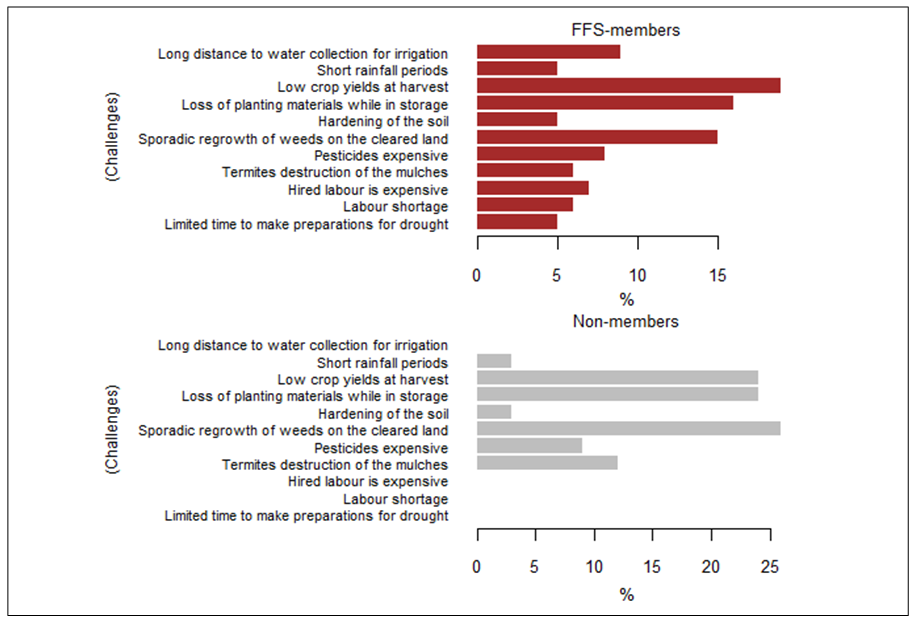 | Figure 2. Challenges faced by FFS-members and non-members in crop production |
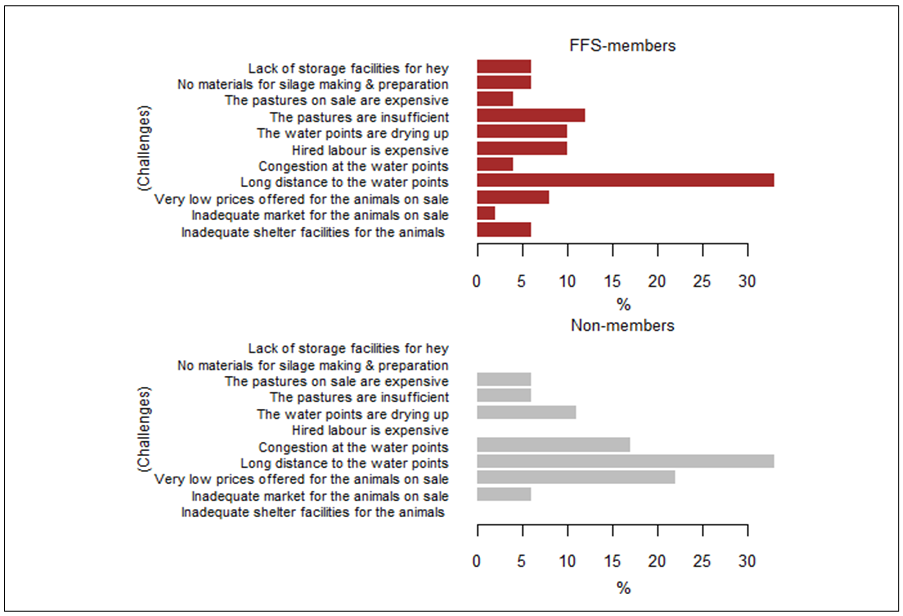 | Figure 3. Challenges faced by FFS-members and non-members in livestock production |
4. Discussion
- The FFS contributed to their member’s adaptation to drought through early and delayed planting, carrying out micro-irrigation, growing of vegetables, rainwater harvesting and application of organic manure. This was because the FFS emphasize hands-on participatory training sessions (Godtland et al., 2004). The FFS also integrated local knowledge and increased awareness and understanding of drought adaptation actions that were not obvious or easily observable by some farmers (Braun et al., 2011). Those engaged in livestock rearing learnt to adapt by fetching water for the animals, collection of livestock feeds and growing of hay. It must be noted that the non-FFS-members applied the least adaptation responses because of their limited scope of adaptation knowledge and experience. This observation relates to the findings of Doss (2001) who also reported that the FFS are a source of information in addition to the promotion of science-based knowledge and practices that helped farmers adapt to drought. This is also in conformity with the findings of Lugalambi & Tabaire (2012) and Egeru (2012) who noted that most Ugandan farmers learned adaptation responses from radios simply because of high penetration and affordability. Another, significant factor in the adaptation of taught farming practices was the role of women and men in the study area. In crop production, the female FFS-members learned and adapted practices such as early planting, irrigation, delayed planting, growing vegetables and application of manure among others as drought responsive mechanisms that facilitated improved growth in planted crops and soil fertility. The male, on the other hand, participated in the mulching and weeding of farms. For livestock production, the female respondents adapted by fetching water from wells, ponds and boreholes for the animals, harvesting and storing of feeds, the sale of livestock, growing of hay and hiring of shelter for livestock. Most of the adaptation responses were highly practiced by the women because of their high engagement in farming, low literacy and income levels. This is in agreement with the findings of Davis et al. (2012) who observed that the FFS are a useful approach to increase production and income of small-scale farmers in East Africa especially women who were found to have low literacy levels.In crop and livestock production, drought causes withering of crops and drying up of water sources resulting into farmers travelling for longer distances to the water sources and low crop yields. This observation relates to the findings of Opiyo (2011) who observed that the distribution of water points in the dry season influences the distances livestock herds travelled from their homesteads.
5. Conclusions, Recommendations and Implications
- In crop production, the FFS members largely responded to drought by early/delayed planting, carrying out micro-irrigation, growing of vegetables, rainwater harvesting and application of organic manure; while in livestock production, they fetched water, sold livestock, grew hay, hired shelter for livestock protection and collected feeds. These divergent options were incomparable to those applied by the non-FFS members. Despite the memberships, the women were more directly involved in crop and livestock adaptation related activities compared to their counterparts. The males, on the other hand, participated in the labour intensive practices like mulching and weeding of farmlands. The high adaptation of responses by the FFS-members was attributed to the high number of women engaged in crop and livestock production. Therefore, the farmers should be encouraged to join the FFS in order to improve and widen their knowledge and practical skills on drought adaptation responses.
ACKNOWLEDGEMENTS
- This study was financially supported by USAID and implemented through FHI 360 and Makerere University Centre for Climate Change Research and Innovation (MUCCRI). Great appreciation also goes to the Hunger Project Uganda staff especially FFS coordinator, Ms Abbo Hellen Owasa and local council members who facilitated the data collection process in their respective sub-counties.
 Abstract
Abstract Reference
Reference Full-Text PDF
Full-Text PDF Full-text HTML
Full-text HTML

